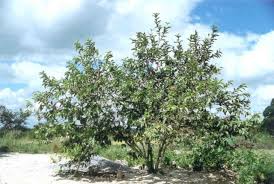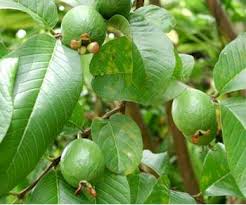Psidium guajava Linn
| Botanical Name | Psidium guajava Linn |
| Order: | Myrtales |
| Family: | Myrtaceae |
| Genus: | Psidium |
| Species: | P. guajava |
| Common Names: | English Name: Guava |
Plant Synonyms
Plant Local Names
Hausa Name: Goiba
Igbo Name: Ugwoba, gova
Plant Habitat
Sometimes cultivated but very common as an adventure in pastures and wayside thickets
Plant Material of Interest
Leaves, fruit and rootbark.
Plant Description
Shrub or small tree, rarely over 7m high, with bark peeling in large smooth thin flakes. Leaves opposite in pairs on 4 angled twigs, elliptical of oblong, 7- 14cm long, appressed- hairy beneath pellucid-dotted. Flowers usually solitary, the calyx closed in bud. Petals white, stamens numerous. Fruit globose, or pear shaped, mostly up to about 6cm long, ripening yellow with yellow or pinkish flesh, strongly aromatic (Seaforth et. al., 1983)
Plant Used Parts
Plant Uses
i. Decoction of leaves is used to treat stomach pain.
ii. Boiled with other leaves to cure fever.
iii. Decoction of fresh leaves is used as remedy for diarrhoea.
iv. Leaves are chewed to relieved toothache.
v. Leaves are boiled with lemon grass and the decoction taken for cough.
vi. Ripe fruit is mainly laxative, unripe fruit is astringent and anti-diarrhoetic. (Medicinal plants of Nigeria, 2006)
vii. Leaves are used in diabetic preparations.
viii. Infusions of leaves is used to promote fertility in women. (Ogbochukwu, 2005)
Plant Therapeutic Action
Plant Precaution for Use
Plant Adverse Effect
Plant Contraindication
Plant Dosage Forms
Plant Dosage
Plant Storage
Plant Chromatographic Fingerprint
Plant Constituents
Guava contains tannin, beta-sitosterol, maslinic acid, guaijavolic acid, essential oil (mail caryophyllene, beta-bisabolene, aromadendrene, beta-selinine, nerolidiol, caryphyllene oxide and sel-11-en-4alpha-ol) and tritepenoids including oleanolic, ursolic, crategolic and gauijavolic acids. It also contains mucilage, pectin, small amount of protein and fats, minerals mainly (K, Ca, Fe, and P) and vitamins A and B (Pamplona-Roger, 1999). It is rich in carotenoids such as phytofluene, beta-carotene, gamma-carotene, lycopene, beta-cryptoxanthin, rubixanthin, cryptoflavin, lutein an neochrome (Mereadante et. al., 1999). Alanine, alpha-hydroxursolic acid, alpha linoleic acid, araban, arabinose, arabopyranosides, ascorbigen, Asiatic acid, avicularin, benzaldehyde, butanol, catechol-tannins, crataegolic acid, D-galactose, ethyl octanoate, glutamic acid, goreiahic acid, guafine, guavacoumarin guaijavarin, guajavolide, histidine, hyperin, ilelatitol D, isonencoumarin, isoquercetrin, jacoumarin acid, lectins, leucocyanidins, linoleic acid, lysine, mecocyanin, obtusin, octanol, oleic, palmitic, palmitoleic acids, polyphenols, serine, sesquiguavene and terpenes have been reported.
Also reported are myricetin, methyl gallate, ellegic and caffeic acids, 8,3-dimethoxygossypetin, quercitrin, ellagitannin and guavins. Begum et. al., (2004) reported a new triterpenoid guajanoic acid in addition to other known ones including uvaol, An enzyme, guave 13-hydroperoxidase lyase has been isolated, while Begum et. al., (2002a), reported the presence of guajavonoic acid and Bergum et. al., (2002b) reported guavonoic acid, guavacoumarin acid, 2alpha-hydroxyursolic cid, jacoumarin acid, isoneriucoumarin acid, and beta-sitosterol-3-O-beta-D-Glucopyranoside. Aglycones and glycosides detected include daidzein, genistein, formonometin, biochanin A and prunatin, along with the immunoreactive isoflavones glycitein, glyycitin, ononin and sissotrin (Lapcik et. al., 2005)


